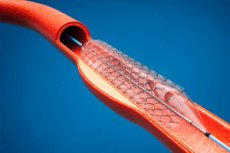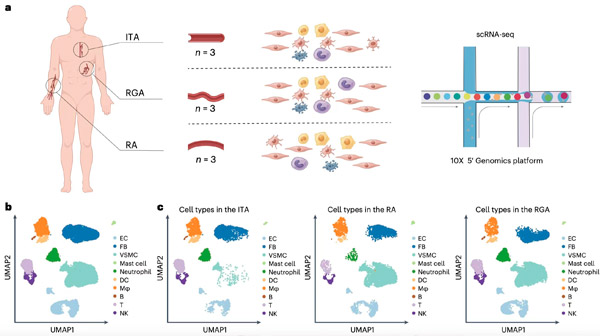Nye publikasjoner
Forskere avdekker molekylære mekanismer i donorarterier for koronar bypass-transplantasjon
Sist anmeldt: 02.07.2025

Alt iLive-innhold blir gjennomgått med medisin eller faktisk kontrollert for å sikre så mye faktuell nøyaktighet som mulig.
Vi har strenge retningslinjer for innkjøp og kun kobling til anerkjente medieområder, akademiske forskningsinstitusjoner og, når det er mulig, medisinsk peer-evaluerte studier. Merk at tallene i parenteser ([1], [2], etc.) er klikkbare koblinger til disse studiene.
Hvis du føler at noe av innholdet vårt er unøyaktig, utdatert eller ellers tvilsomt, velg det og trykk Ctrl + Enter.

Koronar bypass-transplantasjon (CABG) er en kirurgisk prosedyre som forbedrer blodstrømmen til hjertevevet og effektivt behandler myokardiskemi forårsaket av koronar arteriesykdom. Ved CABG tas et friskt blodkar fra pasienten og kobles til den syke arterien slik at blodet kan omgå den blokkerte delen av koronararterien.
De viktigste friske karene som brukes til koronar bypassoperasjon (CABG) inkluderer arteria mammaria interna (ITA), arteria radialis (RA) og arteria gastroepiploica høyre (RGA). Blant disse donorarteriene gir ITA det beste langsiktige resultatet, mens RA og RGA er utsatt for intimal hyperplasi, aterosklerose og vasospasme.
Et team ledet av Wang Xiujie fra Institute of Genetics and Developmental Biology (IGDB) ved Det kinesiske vitenskapsakademiet, i samarbeid med et team ledet av Song Jianping fra Fuwai Hospital ved Det kinesiske vitenskapsakademiet, brukte enkeltkjerne-RNA-sekvensering (scRNA-seq) for å studere celletypesammensetningen og genetiske uttrykksprofiler til ITA, RA og RGA.

Profilering av 38 814 enkeltceller isolert fra tre typer donorarterier. a. Skjematisk fremstilling av den overordnede studiedesignen; b. UMAP-plott av de samlede donorarteriedatasettene, celler farget i henhold til hovedcelletypene; c. UMAP-plott som viser sammensetningen og likhetene til hovedcelletypene i hver donorarterie. Kilde: IGDB
Forskerne fant at disse tre typene donorarterier er forskjellige i sin evne til å absorbere lipidpartikler, hemodynamikk, vasospasme og fibrose. Kombinert med eksperimentell validering i humane celler og mus ble følgende fire optimaliserte strategier for CABG foreslått: hemming av makrofagmigrasjonsfaktor kan redusere intimal hyperplasi av RA; kaliumkanalaktivatorer kan motvirke vasospasme av RGA som ikke responderer på kalsiumantagonister; hemming av CREB5 og GDF10 kan redusere ekstracellulær matriksavsetning og fibrose ved RA og RGA; PCSK9-hemmere anbefales for lipidsenkende behandling ved ITA.
Denne studien forventes å gi veiledning for utvikling av kliniske strategier for CABG og valg av postoperative medisiner.
Artikkelen, med tittelen «Strategier for optimalisering av arterielle transplantater på enkeltcellenivå», ble publisert i tidsskriftet Nature Cardiovascular Research.
